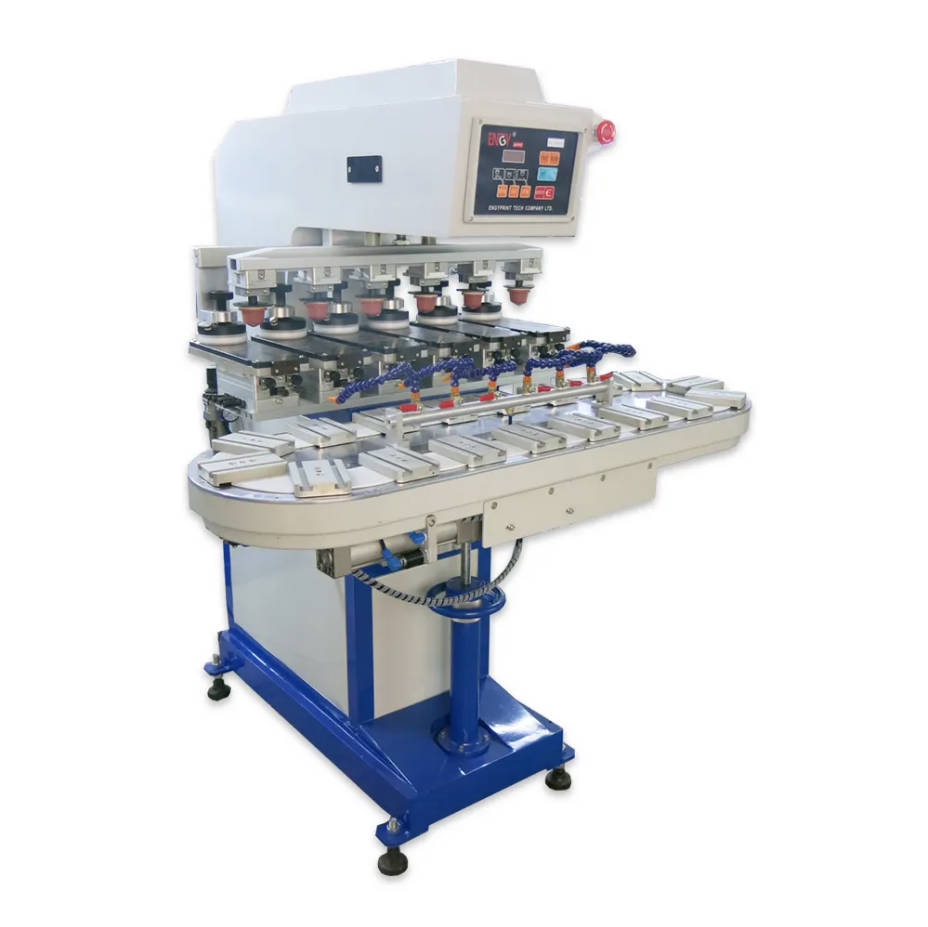Introduction:
Pad printing machines are crucial in the printing industry, particularly for applying designs on irregularly shaped objects like perfume bottle caps. However, achieving precise colour registration in multi-colour pad printing can be challenging. In this article, we’ll explore the techniques employed to optimize colour registration in pad printing machines. Understanding these techniques is essential for potential buyers, especially those in the market for pad printing machines for their perfume bottle caps. Let’s explore pad printing and how colour registration can be optimized for impeccable results.

Understanding Color Registration:
Colour registration in pad printing refers to the alignment and overlap of different ink colours to create a cohesive and accurate image on the substrate. This process is vital for ensuring that the final printed image appears crisp and vibrant, especially when dealing with intricate designs like those on perfume bottle caps. Precise colour registration is essential because even the slightest misalignment can result in blurred or distorted images, leading to unsatisfactory print quality. Common challenges in colour registration include ink bleeding, substrate distortion, and variations in printing pressure.
Techniques for Optimizing Color Registration:
1. Machine Calibration:
Proper calibration of pad printing machines is fundamental to achieving optimal colour registration. Calibration involves adjusting printing pressure, speed, and viscosity to ensure consistent and accurate ink transfer. Printers can minimize misregistration and achieve precise colour alignment by fine-tuning these parameters.
2. Precision Engineering:
Pad printing machines with high-quality engineering and construction are essential for reliable colour registration. Features such as robust frame structures, precision-machined components, and stable printing platforms minimise vibrations and ensure consistent print quality. Buyers should prioritize machines with advanced engineering to enhance colour registration accuracy when evaluating pad printers.
3. Advanced Software Integration:
Modern pad printing machines often come equipped with sophisticated software solutions for colour management. These software packages offer features such as colour profiling, ink-mixing algorithms, and real-time monitoring of registration accuracy. By integrating such software into their workflow, printers can streamline the colour matching process and achieve precise registration across multiple colours.
4. Quality Control Measures:
Implementing rigorous quality control measures is essential for consistent colour registration in pad printing. This includes regular inspection of machine components, calibration checks, and verification of printing results. By monitoring and addressing deviations from the desired registration accuracy, printers can ensure that their output meets the highest quality standards.
Case Studies and Examples:
1. Case Study 1:
A leading perfume bottle caps supplier invested in a state-of-the-art pad printing machine with advanced software integration capabilities. By leveraging the software’s colour profiling feature, the supplier achieved remarkable improvements in colour registration accuracy. As a result, they could consistently produce vibrant and precisely aligned designs on their bottle caps, enhancing the overall aesthetic appeal of their products.
2. Case Study 2:
Another manufacturer faced colour registration challenges due to substrate material variations and printing conditions. After implementing a comprehensive quality control program, which included regular machine calibration and operator training, they observed significant enhancements in colour registration consistency. By closely monitoring the printing process and addressing any issues promptly, the manufacturer achieved remarkable improvements in print quality and customer satisfaction.
Considerations for Buyers:
1. Factors to Consider:
Buyers should consider several key factors when purchasing a pad printing machine for optimal colour registration. These include the machine’s precision engineering, software capabilities, and compatibility with their specific printing needs. Factors such as ease of use, maintenance requirements, and supplier support should also be considered to ensure a seamless integration into their production workflow.
2. Questions to Ask Suppliers:
Potential buyers should inquire about the pad printer’s colour registration capabilities during the purchasing process. They should ask suppliers about the machine’s calibration procedures, software features for colour management, and any additional tools or accessories available to optimize colour registration. Furthermore, requesting demonstrations and samples of printed outputs can provide valuable insights into the machine’s performance and registration accuracy.
3. Importance of Testing and Demonstrations:
Before making a purchase decision, buyers should insist on testing the pad printing machine under real-world conditions. This may involve conducting print trials using their substrates and designs to assess colour registration accuracy and overall print quality. Additionally, attending live demonstrations or visiting supplier facilities can offer valuable hands-on experience and help buyers make informed decisions.
Conclusion:
In conclusion, optimizing colour registration in multi-colour pad printing machines is essential for achieving high-quality printed outputs, particularly for applications like decorating perfume bottle caps. By employing machine calibration, precision engineering, advanced software integration, and quality control measures, printers can enhance colour registration accuracy and produce impeccable results.
For potential buyers of pad printing machines, understanding these techniques and considerations is crucial for selecting the right equipment that meets their specific requirements. Buyers can make informed decisions that ensure optimal colour registration and overall print quality by evaluating factors such as precision engineering, software capabilities, and supplier support.
As technology advances, the future of colour registration in pad printing holds even more tremendous promise. With ongoing innovation and refinement of techniques, printers can expect further improvements in color-matching accuracy and efficiency, ultimately leading to enhanced productivity and customer satisfaction.
In summary, investing in the proper techniques and equipment for optimizing colour registration is essential for achieving success in the competitive world of pad printing, and it is a decision that buyers should carefully consider to ensure long-term success in their printing endeavours.







